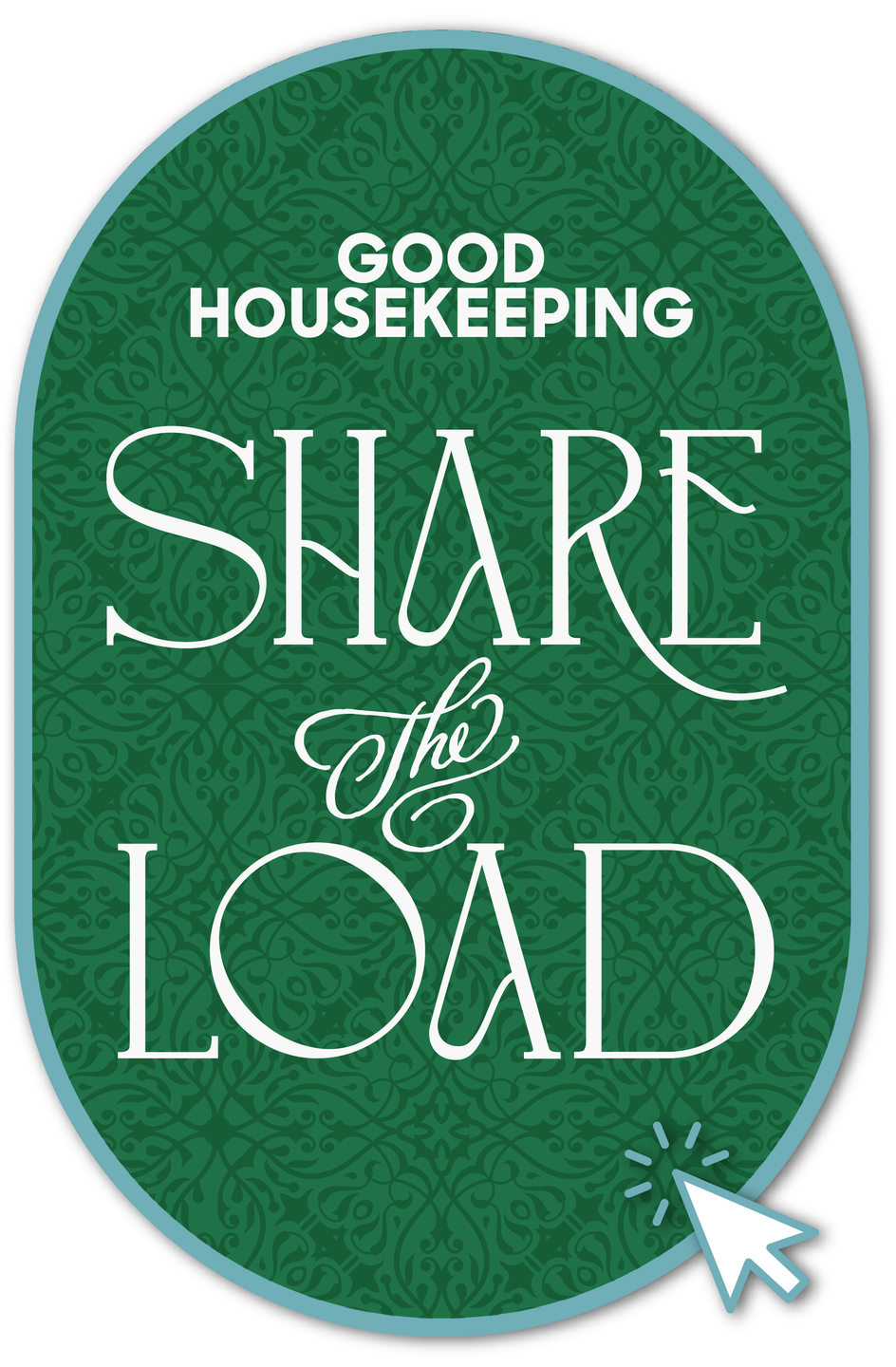For Some Families, Covid-19 Was the Perfect Household Shake-Up for Splitting Chores

"Hearst Magazines and Yahoo may earn commission or revenue on some items through these links."

They say every cloud has its silver lining — and while it can be hard to find unvarnished upsides to the monstrous menace that has been the COVID-19 pandemic (at least not without feeling somewhat ghoulish), I’d be lying if I said the first year or two of the pandemic didn’t have a bit of a bright side for my family. Because when the world shut down and my husband joined me at our extra-wide desk for full-time remote work, the way we shared the responsibilities at home changed in many ways.
For the past decade or so, I’ve been fortunate enough to carve out a career that takes place mostly in my joggers and mostly at home. With two kids ages 9 and 13, that’s allowed me the time to feed the cats, accommodate sick kids and do 10 jillion other things. These are tasks that often fall to the parent who is more available and flexible — in heterosexual relationships, often the woman.
And my husband, who was no longer commuting up to three hours a day to work or traveling to meetings on the West Coast and elsewhere, was suddenly around to hear the 6 p.m. haiku — What is for dinner?/ No, anything but that, no!/ But we’re so hungry! — and could walk over to the kitchen (or to the store) and help start the process. The after-school math homework meltdowns still took place in the living room — only now the live-in tutor (my husband) could pop in while they were happening, not hours after the fact. He could spend his lunch break hauling our two enormous, yowling cats to their checkups, take note of the fact that our stash of garbage can liners had dwindled to zero or kill time between calls vacuuming up the crumbs under our shared desk.
Many families noticed these changes and many others — especially how fathers were able to be present and more involved at home — during the pandemic. When the Pew Research Center asked fathers in 2017 and again in the fall of 2020 — Peak COVID, that is! — whether they felt they were spending enough time with their children, the share who said they spent too little time with them decreased from 68% to 48%. A survey by Harvard’s Making Caring Common project in June 2020 found that more than two-thirds of fathers said they felt closer to their children since the pandemic started, perhaps because of the added time doing child care and other domestic tasks.
Not that all of this has stuck. In fact, according to a survey released in early 2023, for many families the division of labor in opposite-sex partnerships has reverted to what it was before the pandemic. (Just one-fifth of fathers reported continuing to do more child care than before and one-quarter of fathers have continued to do more household work, the survey found.) The survey also found that lower-earning fathers who could work remotely (in jobs like customer service or tech support, for example) were most likely to have kept up the nontraditional division of family labor.
Nancy, a professor and writer in New Jersey definitely is happy with how the pandemic upended things at home and prompted changes — ones that have stuck. “Once we were all home, our daily routine was so profoundly interrupted that it gave us time to reset a bunch of stuff," she says. "When the kids had free lunch at school, that was what they ate, and my husband kept track of the menus that came home so they could tell their teacher what they wanted. Then, once free lunch went away, the kids wanted to start taking lunch again, and my husband took over packing lunches.” Happily, as things have gone back to “normal,” Nancy says they’ve kept up those patterns: “It feels particularly important that the kids are seeing a more equal division of labor. They can grow up seeing their dad also handle lunches, school dropoff and pickup, after-school activities, etc. — that’s an example of being a partner and a parent that I want them to follow too."
The pandemic truly was the impetus for a lot of couples to have some very important — and sometimes difficult — conversations, says Sheryl Ziegler, Psy.D., a family and child psychologist in practice in Denver. “Before the pandemic, it was hard to get traction on some of these things, particularly when it came to some of the invisible labor partners do. But once everyone was home, it all came out into the open and onto the table.” Of course, three years later, many things have gone back to the way they had been, says Ziegler: “It takes a lot of intention to keep it all going. When two people were home, that was easier to do.”
But the division-of-labor changes are not the only unexpected pandemic upsides some people found. Jessi Hempel, the author of The Family Outing and hosts the LinkedIn “Hello Monday” podcast, is married with two kids. For her, the silver lining of the pandemic she feels wistful for — and fraught about — was how it changed how her family interacted with their neighbors. “A feeling of guilt accompanies my thoughts about the pandemic,” she says. “I understand objectively that 2020 was a terrible time for our country broadly and for my community, but I think a little bit of the reality of that feeling has receded. I also remember what it felt like to depend on our neighbors, people we didn’t even know before the pandemic. The couple next door to us had twin boys the same age as our son, and they suggested we ‘pod up.’ We fixed meals together. We balanced child care and shared workspace. We watched each other’s kids. Before the pandemic, there were all these things my wife and I would pay for — babysitting, housecleaning, odd jobs — that made life as a nuclear family manageable. But during the pandemic, we could’t do that. And we found ourselves asking for help. And offering it. A lot. And, honestly, it felt really great.”

And Hempel truly thought that this would continue, even as the pandemic receded. “We all thought we'd keep it up,” she says. “But we didn’t. We couldn’t. Now, in 2023, we’re back to texting each other to make plans and having them fall through half the time. We’re back to paying for help in our home, to saving time with friends/neighbors for ‘leisure time.’”
Kate Rope, a writer in Atlanta and the author of Strong as a Mother, credits the pandemic shake-up with bolstering her marriage. “I work from home, and my husband has always had full-time office jobs,” she says. “Most of the household management fell to me. And, even though he is absolutely committed and engaged in our kids’ lives, it often felt as if I didn’t really have a co-parent since I was home and handling everything: making lunches, pediatrician appointments, driving to activities, not working when they needed to stay home sick, all the planning, etc.”
With her husband at home during COVID, that completely changed. “I finally felt like we were truly coparenting," she says. “It has made a huge difference in our family and in our marriage.” For example, Rope notes that during lockdown, her teenage daughter became vegan. “My husband, who until that point almost never cooked for us, researched vegan meal kits and began cooking two meals a week, which was a gateway into him making dinner even without a kit, which he now does on a regular basis. Game changer.”
It wasn't just the rejiggered to-do list, Rope says, but also the sudden feeling of really being a team that was truly satisfying. “My husband and I have always done better the more time we spend together. Things get tough when we are going our own ways and just seeing each other in passing. Having concentrated time where we acted like a team and got to engage in small jokes and little connected moments throughout the day brought us back to how our relationship felt in the very beginning. I know this was not the case for so many, and I was so grateful that it was the opposite for David and me. It reignited a spark, solidified our parenting partnership, and the kids reaped benefits as well. I still feel all those benefits even today as he has gone back into the office. Luckily, he works from home two days a week. and that helps maintain our new normal.”
While things in my own home have shifted again as of late — my husband now has to work out of town three days a week — I do think he has a much clearer picture (and greater appreciation) of what’s happening behind the scenes while he’s gone than he ever did before the pandemic.
And on the two days a week when he can be found at his laptop, about two feet to my left, we are much more 50/50 than ever before. Side by side at our desk, we can go back to this year’s new normal, which, let’s be honest — is both of us pretending we didn’t just hear the kids ask, “What’s for dinner?”
Photography by Mike Garten; Prop Styling by Alex Mata.
You Might Also Like

